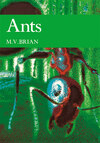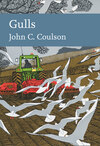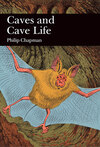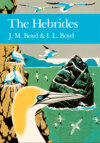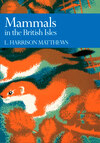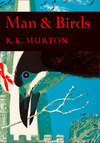Kitabı oku: «Ants», sayfa 4
SEED EATING
Whereas prey provides mostly protein and oil and decomposes quickly, seeds are also rich in starch and they store well, provided germination can be prevented. Seed storage is a regular feature of ants that live in deserts where seed-producing, ephemeral plants may be quite common and the main source of food. Even in this country Myrmica, when it lives in acid grassland, collects the seeds of Potentilla erecta, but whether they are eaten or merely put in the nest is uncertain. Tetramorium caespitum on the other hand collects a great many seeds of grass and heather in late summer, both from the plant and after searching on the ground. Each seed is picked up and carried away individually; curiously enough, ling (Calluna vulgaris) is favoured, even though it has the smallest seed. Vast numbers are stored in galleries some 10–30 cm below the soil surface and are fed to the growing grubs in spring after a little preliminary mastication by the workers. They form a staple part of the diet and contribute substantially to the growth of the sexual brood in spring. The seeds never germinate during winter, this may simply be due to the low temperature or because they need light, for there is no evidence that the ants treat them in any way. Seed-eating myrmecines from semi-desert areas apparently take a great deal of trouble to keep their stores dry but this is certainly not the case with Tetramorium caespitum whose galleries are soaking wet for most of the year.
Although formicine ants do not collect seeds systematically records of this do exist. Lasius alienus collects the seeds of the dwarf gorse, Ulex minor; it only eats the oily caruncle, the rest is rejected undamaged and will germinate satisfactorily. The suggestion that the gorse is distributed in this way is reasonable. Lasius niger has been seen with viola and primula seeds; again, it only eats the stalk and the caruncle which contain oil and the rest presumably germinates after being thrown away by the ants. Wood ants, too, will take some kinds of seeds if these are put in their tracks; they, too, prefer the oily ones. The trapping results with Formica polyctena already mentioned show that a great many seeds are taken in along with other vegetable matter, such as buds and twigs; even pebbles coated with vegetable oil were picked up and carried away but soon rejected.
NECTAR AND HONEYDEW
Ants lick up many juices that exude from plants, particularly from extra-floral nectaries. A good example is the zone near the base of the growing bracken frond which secretes an attractive solution on the frond pushing up through the soil in early spring. Both Lasius alienus and Lasius niger are very fond of this; they excavate a space around the base of the frond and from positions here they interfere with the passage of other species. A number of species collect from ling, the principal heathland shrub; unlike most plants this has a little protein in its nectar and it is just conceivable that this could help larval growth. Ants are frequently found in flowers that do not produce nectar. Lasius niger may be found in the flowers of the wild poppy which produces only pollen, almost certainly of no use to them. Of course they may be lying in wait for insects attracted by the pollen. Honeybees might be caught by Lasius niger if several ants acted together but there must be many smaller insects that could be overpowered easily. Pollination by ants is not thought to be frequent but it could happen; they might transfer pollen to the stigma in their wanderings and this might be important for some plants; little is known about this. Nor is much known about how plants protect their nectaries from ants; it is usually suggested that a long corolla tube, down which only a bee can get its tongue, is in itself quite adequate, but surely ants could easily bite through to the sugar, at least one species of bumble-bee does. Honeydew is not strictly a plant exudate, for in passing through the body of the bug (usually an aphid or a scale insect) it undergoes considerable change. Aphids receive the sap more or less passively as it is under some pressure from inside the plant; they control its flow by means of a valve in their head; others feed actively as well. Though the food-carrying channels of the plant (sieve tubes of the phloem) are the most usual place from which the bugs obtain nutriment, there are some which feed on other parts, such as the leaf tissues. Honeydew has had some food substances taken out and some excretory products added. It is now known to contain a mixture of sugars, organic acids, alcohols, plant hormones, salts, vitamins, amino acids and amides. It is difficult to quantify this as it varies with the age of the plant and the aphid position on the plant, as well as the current weather and season but 10% dry material is probably a fair average. Most of this is carbohydrate but about one-third may be nitrogenous. Not only are the ordinary plant sugars present (glucose, fructose and sucrose) but some additional ones appear to be synthesized by the aphid itself; such is melezitose. The nitrogenous compounds are mainly amino acids coming directly from the plant sap, of which at least twelve kinds are common. There are no proteins. This means that honeydew can provide many of the growth substances needed but in rather small quantities. Laboratory experiments have shown in fact that auxiliary protein sources are needed for normal growth. However, during winter, honeydew from root-feeding aphids may yield enough amino acids to maintain the protein reserves of adult ants in a very satisfactory state.
The relationship between these bugs and ants has evolved from one of casual contact in which the latter merely scavenge for bug excretions lying on leaves, as do honeybees, wasps and very many other insects, to one involving a very high degree of mutual dependence. The relationship between the common Lasius niger and the Black Bean aphis, Aphis fabae, on the broad bean, has been carefully studied recently. The ant keeps the bean free of sticky honeydew in which moulds are likely to grow and prevents the aphis cast skins from adhering. This is because instead of ejecting their excretions freely, as they do if unattended, these aphids wait until an ant touches them and then release a droplet of honeydew. They quite clearly save this up, for if the ant refuses to collect, it can be and often is withdrawn. Aphids also wave their hind legs in the air less when ants are about. All these and other behavioural changes persist for some time after all the ants have been taken away. They vanish only gradually.
Other aphis species that are more often associated with ants have lost their ability to excrete independently. Instead of a large tail-piece (cauda) that helps in the ejection of fluids they have a small one and a ring of hairs round the anus that holds excrement until the ants can suck it up. Also, instead of a pair of cornicles at the rear of the abdomen that secrete quick-setting, deterrent waxes, they are without such weapons. Underground aphids do not usually shoot their excrement away; it is collected on wax plates and put in the soil crevices, but those which are regularly associated with ants simply have the circle of hairs round the anus.
Ant-attended bean aphids produce about twice as much honeydew as unattended ones and Aphis sambuci with wood ants give three times as much honeydew as normal. No doubt this arises partly from the extra contacts that the ants provide, exciting the aphids and making them eat more and hence, of course, excrete more. Possibly, too, the instant removal of these liquids prevents accumulation starting an inhibitory back action. Other factors are certainly involved; thus, the part of the plant on which the Bean aphis feeds is actively influenced by Lasius niger. They remain for much longer on the younger, more productive tissues where presumably they obtain better food. The aphids are also kept on the underside of the plant and cluster more tightly into larger groups. Both a rich food supply and high density are known to increase the tendency for sexual forms to be produced in ant-free conditions and yet when ants are present this increase in reproductive rate is very much delayed. The complete answer to this question is not yet known; at the moment it is thought that indirect influences on the movement of aphids are more likely to be important than direct ones which act physiologically.
It has often been noticed that Lasius niger protect their aphids from some of their enemies; they remove the larvae and even the eggs of ladybirds and hoverflies; the adult ladybird, though too big for them to lift, can be driven away. Not all observers agree about this, and it is true that some ladybirds and hoverflies can avoid workers of Lasius niger; so, too, can a number of insect parasitoids and indeed, one of these animals has evolved the ability to parasitize aphids underground and even take honeydew from them whilst ants are in attendance; the ants may even feed it. Such a special case in no way invalidates the generality that ants reduce interference with aphids by their enemies. The degree of ant vigilance and sensitivity probably decreases with the distance of the group of aphids from the ant nest and with the current state of their food supply. Much variation is also found between ant species in this respect, for Lasius flavus is undoubtedly able to exclude aphid enemies more effectively than Lasius niger, though this might simply be due to the fact that their nests are closed and their aphids live underground. The wood ant is also known to repel, if not attack, parasitic insects but is said by some ecologists to be less effective against hoverflies and ladybirds. Many aphids and coccids attended by ants have shelters of soil and vegetable particles built around them. These must help the ant to keep off dangerous animals as well as providing a more equable microclimate, not only for the benefit of the bugs but also for the ants which are reluctant to forage in wet and windy weather. Formica rufa cannot construct aerial chambers and loses a lot of aphids during storms but it does excavate underground and some of its aerial aphids may be found there.
Many underground aphids have evolved high degrees of dependence on ants, so much so that they are never found alone. They may be moved about and cared for in the same way as the brood. Some ants may bite through tough plant roots so that aphids can find the soft nutritious inner layers but one cannot be sure that this is not an incidental consequence of nest excavation. There is some evidence that some aphids that overwinter in an active state can only survive in ants’ nests where they are protected from fungi and cold. As already suggested they probably supply the ants with easy food at this season. Even the eggs of some species are collected and stored over winter in the nest. Lasius flavus treats aphid eggs as it does its own, licking them and keeping them free of moulds. On hatching, the ants put them with their larvae but they wander about and find their food plant, probably by chance, though it has been suggested that they are put directly on to the correct plant by the ants.
Tropical tree-dwelling ants have evolved a considerable degree of specificity in relation to plant-sucking bugs, which live intimately with or at least near the brood. The same might be expected with root-feeding aphids in temperate areas. At least seventeen species of aphids have been found in the nests of Lasius niger and more in Lasius flavus, whilst wood ants tend over sixty species. In grass heath in the west of Scotland six species of ant use fourteen species of aphid that feed on twenty-one species of plant but there is no evidence at all of specialization by either insect. At the opposite extreme Lasius fuliginosus and Stomaphis quercus are usually associated; though the aphis can exist alone on oak trees and though its eggs are not always protected by the ant it is normal for them to be carried to the best parts of the tree. Even more extreme is the aphis called Paracletus cimiciformis which is exclusively associated with Tetramorium caespitum. It is tended by the ants underground though it seldom feeds on plant roots and produces very little honeydew; in fact the ants feed it on regurgitated food which makes it a social parasite.
The wood ant Formica aquilonia which lives in relict pine forest in the Scottish Highlands and has already been mentioned, collects honeydew from aphids on the twigs of trees. From the difference in the average weight of ants ascending and descending it was calculated that the average weight of a load is 1·9 mg. This is much less than another wood ant (Formica rufa) has been calculated to collect in Europe: 5·5 mg per worker. Estimates of 100 gm of honeydew a day or 50 kg a year have been made for this species in Europe. The larger colonies of Formica polyctena are thought to collect ten times this amount. From one pine tree 250 gm of honeydew was collected each day; this would be about 40 kg per tree per year. Foresters think this a small price to pay for their consumption of pest insects. With Formica aquilonia the average weight of solid prey was 8 mg. As about 300,000 journeys were completed in a 14-hour period from 06.30 to 20.30 and 19% of the loads were prey, one can estimate that 820 gm of food were collected altogether, of which 44% was honeydew (by weight) and the rest prey. With total foragers averaging around 700 gm one can see that each ant brings back roughly one and a half times its own weight of food daily.
ORGANIZATION OF FORAGING
Individual navigation
The workers of the more primitive ant species forage alone. As a rule they are large ants and can carry back large bits of food without help, but some (Myrmica species, Lasius niger and Formica rufa and its allies) may drag back their prey; this depends mainly on its size. Myrmica rubra with workers weighing about 4 mg will drag loads of over 8 mg whilst Formica lugubris with workers of 8 mg will drag loads of over 12 mg. On rough surfaces some smaller loads will be dragged. Sometimes an ant will stop dragging a prey, change its grip and carry it.
They learn their way about the vicinity of the nest gradually, using a number of environmental cues. The principal one in simple species is undoubtedly the light pattern of the habitat; but gravity, chemical patterns and, particularly with underground ants, shape are important. The light pattern is created by the disposition and shape of trees, bushes and buildings against the sky and also the direction of the sun or the polarization pattern of the sky which is closely connected with this. As these last two factors both move some fifteen degrees each hour due to the earth’s rotation they are not much use except for very short trips unless the foragers have internal clocks and the ability to compensate for this movement. In the few cases so far studied they do. Visual orientation is likely to be very important when an ant is dragging prey as it makes many detours round obstacles which necessitate realignment.
Ants measure the intensity of gravity with sense organs at the joints of their legs; this provides an estimate of their angle to the vertical. When travelling in trees and bushes these measurements must be very complex. They can run a long way at fixed angles to the direction of gravity.
With some species, such as Lasius fuliginosus, chemicals left on the substrata are the most important navigational cues; they run with their antennae, which carry olfactory organs, close to the ground. Where traffic is close and dense, chemical traces may be left on the sub-stratum by most ants. It is possible that the vegetation is damaged in this way. This may be why on the tracks of wood ants vegetation is short and sparse; yet they are known to clear away loose materials and they may actually bite some of the shoots away. Those species with underground galleries linking their nest and forage areas must learn their way by a mixture of chemical and tactile stimuli.
Permanent trackways may persist for years, either above or below ground, but little is known about how they start. Wood ant tracks follow animal and human pathways quite often, presumably because it is easier for them to move about but they also make a lot of their own. All these tracks and galleries help individuals to find their way about, for foragers are able to orientate to them as they do to their nest. On returning they can take up the correct direction, presumably from a general knowledge of the terrain, for there is no evidence that these tracks have any intrinsic directional property. The only other possibility seems to be that traffic going nestwards is recognized as carrying food in contrast to traffic going in the opposite direction.
However crooked the ant’s path to food, it goes back to the nest or track, as the case may be, in as near a straight line as it can. This is possible because it has in its brain a mechanism which integrates all the information received by the various senses and produces a resultant.
In those species in which individuals carry the main responsibility for foraging it is very important that they should be able to find their way back to a good food area by carrying a memory of its position. Certainly they explore and learn a lot about the features and structures of the areas they hunt in, but many ecologists have noticed, too, that they have very restricted zones of search so that the total foraging area of the colony is split up or partitioned between different individuals. Presumably this enables them to learn their area thoroughly and aids their ability to return to good spots. The wood ant is a bit of a mystery in this respect. Some ecologists have emphasized the degree to which they partition their feeding grounds and the fidelity which they show to individual groups of aphids. Others have noticed hardly any tendency at all for returning foragers to leave by the same track as they entered. Both views can be reconciled if it is realized that the behaviour may be very flexible in relation to season, type of food collected, age of forager and other factors.
The recruitment of help
The advantage of being able to communicate information about food and collect very many workers quickly in the right place lies partly in reducing the number which are out patrolling at any particular moment and partly in enabling the collection of bigger pieces of food by a co-operative effort. Food, when found, can be quickly covered, monopolized and carried away, either in one large piece or cut up into several smaller bits.
Perhaps the first stage in the evolution of this power can be said to exist when a returning forager alerts its nest mates and makes them run out and search randomly; they might get a clue about where the food lies from whatever it was that the forager brought in if they knew enough about the area. The next stage perhaps would be for a few workers to follow the discoverer out on her return trip. If they kept close enough, and ants have been seen running in tandem almost touching, they should stand a good chance of getting to the food. Again, it is possible to notice a worker with food coming in and vigorously hitting her nest-mates with her forelegs and antennae. This excites them to run outside the nest or to leave the track. Formica rufa and its allies may be at this stage of evolution. They often go towards the excited movements of other ants that have caught prey and are known to increase their foraging in trees which contain resting flies in great numbers. Formica polyctena was given prey in the form of immobilized insects on the ground. When a worker first discovered one of these it did not even pick it up. As it found more it became visibly excited and returned to the track by a short route. It needed to run into prey about twice every five minutes for this behaviour to be triggered. On reaching the track it touched passing individuals in the way already described and they left the track and followed what appears to have been a newly-established trail to the prey area. Once there, the recruits started immediately to pick up the insects and carry them to the track and so to the nest. A tendency to pick up and carry a prey that has already been examined by other individuals has been noticed in other species of wood ant. A very important aspect of this recruitment behaviour is the fact that the first scouting forager assessed the prey density before collecting any and only went for help at high densities. This of course avoids useless recruitment. Big prey are also more likely to start recruitment than small ones but sometimes they are cut into smaller pieces; this varies from one track to another in the same colony as well as from colony to colony.
Many ants undoubtedly lay chemical trails from food areas to the nest or to permanent tracks if these exist. In this country it is known that species of Myrmica and Tetramorium caespitum, Tapinoma erraticum and the formicines Lasius niger and Lasius fuliginosus all do, though the trail may not be very efficient over distances of more than a metre. It is surprising that ants of the genus Formica do not appear to lay trails (with the possible exception of Formica polyctena above). In the great majority of ants the trail is laid from the apex of the gaster, though ants are known which lay trails with their feet. In myrmicine ants the glands which produce the essential chemicals are Dufour’s and (in some genera) the poison gland and it is exuded through the sting which is used as a nib. In the dolichoderine ants it comes from Pavan’s gland which opens posteriorly. In Lasius the chemical is incorporated in the hind-gut material and spread from the anus. The track of Lasius fuliginosus can be made visible to smooth surfaces by dusting with fine lycopodium powder; it consists of a series of spots, each drawn out to a point by the individual as she moves forwards. Curiously enough, this shape could indicate the direction of the track but there is nothing to suggest that the ants appreciate this. Even Myrmica has been thought to lay directional trails but, again, it is uncertain whether this is true or not as decisive experiments are difficult to design and carry out.
In some ants the trail chemical is enough in itself to start an exodus and mechanical palpation by a returning forager is unnecessary. The identity of the chemicals used in trail formation is only just being studied and very little information exists at the moment. It is known that the specificity is very variable: some species will only follow their own gland smear, others will follow those of other species as well; in nature this might be expected to cause some confusion. Too little is known about the factors which induce foragers to lay trails to food. Presumably they try to collect whatever they find themselves and if it is too big and cannot be easily cut up they return for help but the illustration just given in which Formica polyctena seemed to assess the numbers of prey available and then go back for help without taking any suggests that the behaviour may be much more complex and flexible than has hitherto been thought.
Ücretsiz ön izlemeyi tamamladınız.
